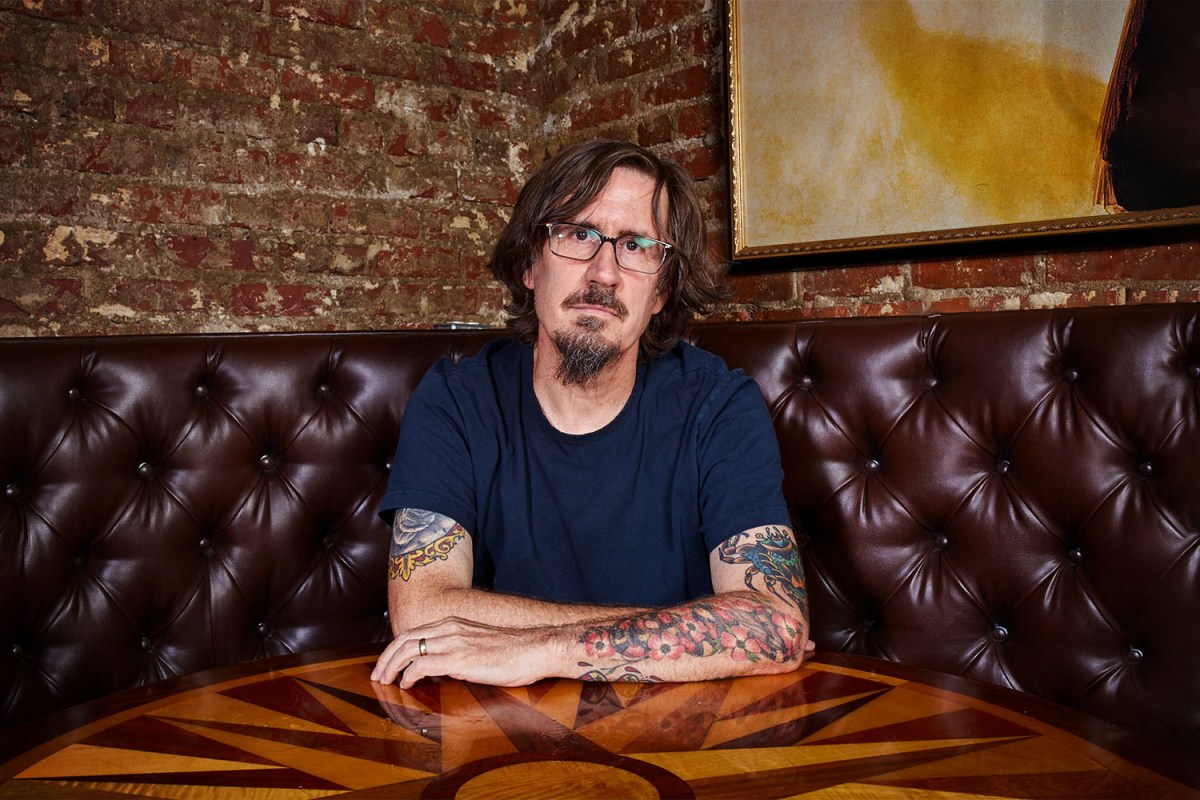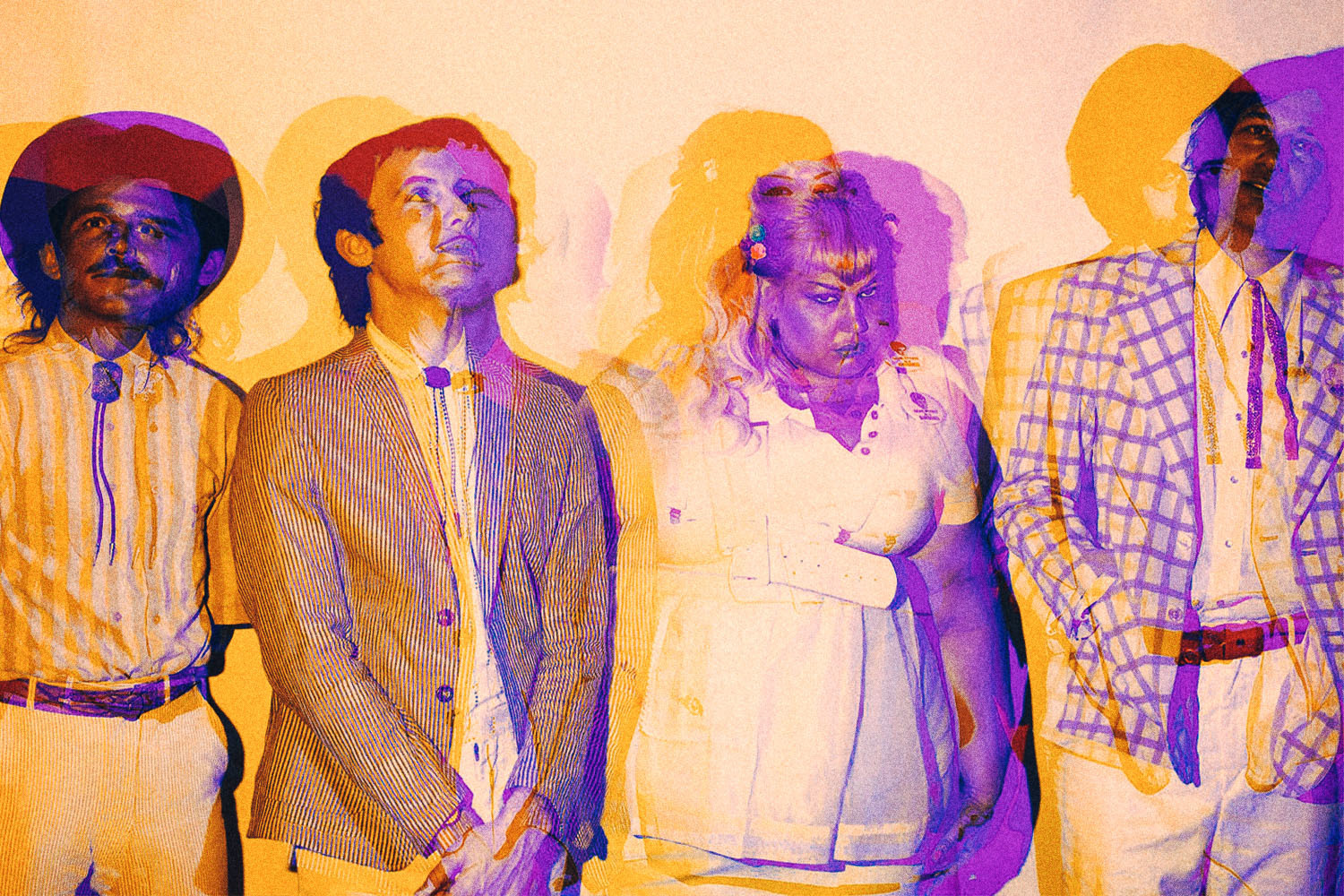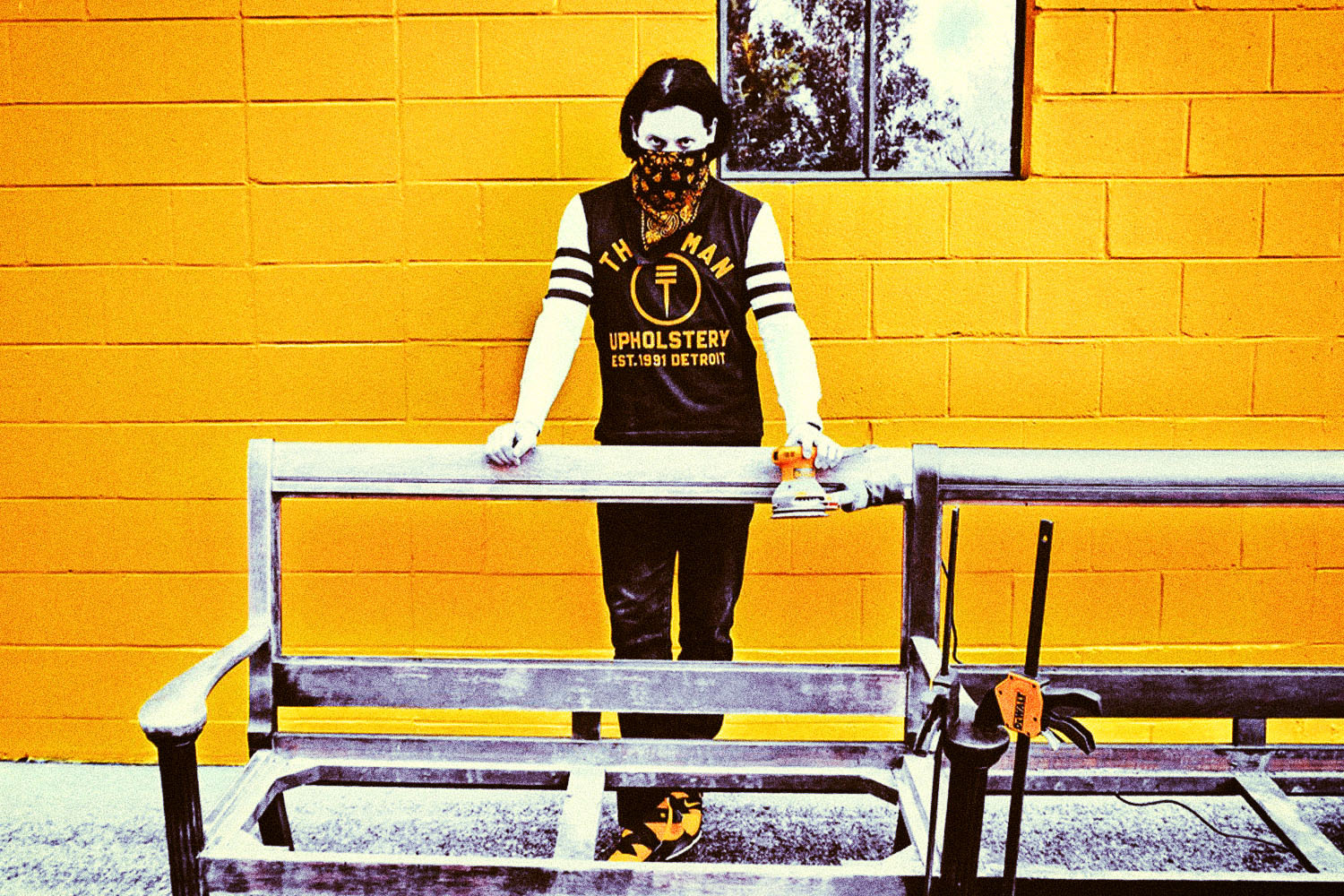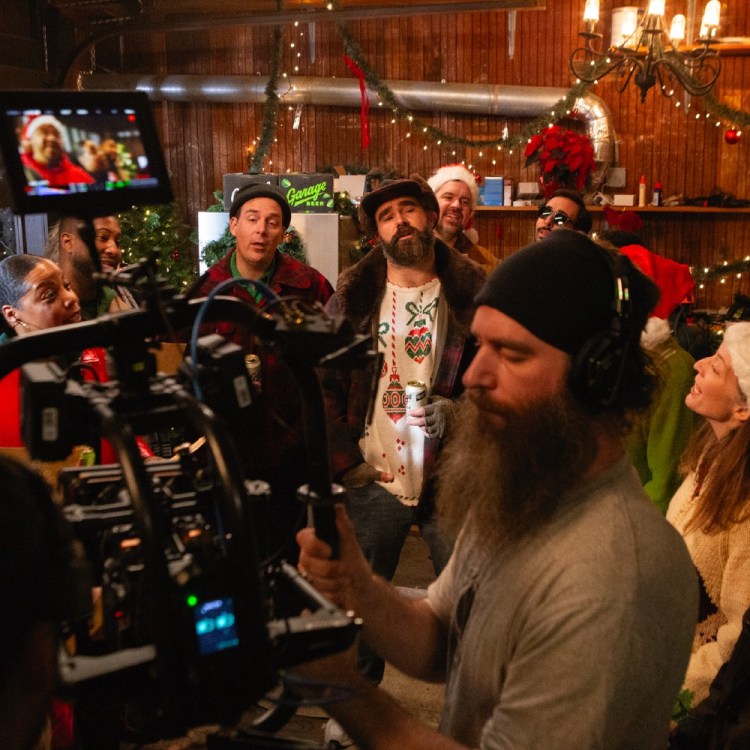For nearly 30 years now, John Darnielle has been recording and releasing records under the name the Mountain Goats, first as a solo musician armed with an acoustic guitar and a boombox and, now, since the mid aughts, as the frontman of a permanent band featuring bassist Peter Hughes and drummer Jon Wurster. He’s a remarkably gifted, singular songwriter who’s produced at a prolific clip for a very long time now.
Since COVID hit, though, he’s been even more prolific than usual., releasing three full-length albums over the course of 15 months. Getting Into Knives was recorded at Sam Phillips’s studio in Memphis in the days just before lockdown, and it sounds like it. Shuffling drums, strutting horns and simmering organs practically serve as a geotag. Songs for Pierre Chuvin, on the other hand, was a throwback to Darnielle’s early days, recorded by himself at home during lockdown on his trusty old boombox as a way to raise some money for his bandmates when they were unexpectedly unable to tour.
Their most recent release, Dark in Here, was actually recorded right after Getting Into Knives, at the legendary Fame studios in Muscle Shoals, Alabama, part of a weeks-long pilgrimage to two of the country’s most important music cities. The album features contributions from Spooner Oldham and Will McFarlane, who’ve played on a seemingly endless list of records beloved by many, including Darnielle.
As you realize very quickly once you start talking to him, he is, first and foremost, a massive music nerd. During our 20-minute conversation, he spoke at length about everyone from Bonnie Raitt to Depeche Mode, his knowledge encyclopedic and his passion contagious. He also spoke about what it was like to keep the Mountain Goats afloat during a global pandemic and the artistic freedoms he’s earned three decades into his career. Below, a condensed version of that conversation.
InsideHook: You’ve now released three records since COVID hit, which under normal circumstances I imagine would have kept you pretty busy with touring and promotion and all that — none of which you’ve been able to do, really. So how have you, aside from releasing records, managed to keep yourself busy for the past year and a half?
John Darnielle: Staying busy has not been a challenge, I have to say. There are things to do. Just keeping all the plates spinning, to keep everybody’s rent paid. When all your income comes from touring, that was a big challenge. It’s all hands on deck to figure out what exactly to do. But also, I have two children who go to school, so that kept me plenty busy. It’s actually been much busier than usual, because otherwise, the pattern of release and tour is a comfortable pattern. I’m used to it. That’s a workload that is predictable, and I know how it works. Instead, I just had to keep a whole bunch of balls juggling in the air at the same time. So yeah, it’s been very, very busy the past year. I got no complaints, I like to be busy. It’s pretty intense.
So how did you guys manage to keep the bills, if you don’t mind me asking? Was this a band-wide conversation? Were there any makeshift solutions along the way that you turn to?
So, man, I don’t want to claim any foresight or anything, but I used to be a nurse, and when we finished Getting Into Knives, I thought, “Oh this sounds real bad.” It was clear that the world was going to change. I’d had an idea while we were recording for the next album, or maybe the album after the one we were making. My idea was to write something about the last patient I had as a nurse. So I had already started writing a song, and then when I got home, I said, “Well, what if I want to record now? I’ll write a song a day for the next 10 days and see what happens.” I recorded all of them on the boom box. I figured I’d try to release it as quickly as possible, on tape, as a limited edition or something, in the hopes of raising some money, and then we’d split the money four ways. I made the tape, but the money was for everybody in the band. People have this idea that art only comes from this place of inspiration, but I love practical art, also. Those songs came from my gut and are real songs — but also a big reason I was writing was to keep my bandmates paid. That was, for me, a real pleasure to be able to do.
But there were also more pedestrian things, like there was a government loan program that involved tons of crazy paperwork and stuff. So getting that sorted was also part of it. And getting the live stream shows we did together.
Could take me back to the week you guys went into the studio to make Dark In Here? In the essay accompanying the record, Peter talks about how going into the studio is kind of an isolating experience under normal circumstances. And that even despite that isolation, there was still, like you said, a sense that things were slowly becoming more and more fucked with every day. Could you explain what that was like and how the severity of the situation kind of began to sink in and how it eventually maybe seeped in and affected the record that you ended up making?
So we were making two albums in two weeks. The idea was to release both last year. One was Getting Into Knives and the other was Dark in Here. We had done Getting into Knives the previous week at Sam Phillips’ studio in Memphis. Then, on our day off, we drove down to Muscle Shoals and we started making the second record. When we started making the first one, there were whispers. There was news about what was going on in China, and it was known. And there had been a case, but it wasn’t very clear that it was actually going to be a pandemic.
Again, we’re in a state of isolation, where if you want to disengage from the news cycle in the studio, you don’t have to know any of that shit. It’s amazing. It’s great. One of the great blessings of the studio is it’s a great place to protect yourself from the stuff that, normally, even if you enjoy thinking about it, is kind of oppressive.
But there were various takes in the studio about what it was actually going to be like. To me it looked pretty bad from the outset, and it was when they canceled South by Southwest that I was like, “Oh, somebody knows something I don’t know about how severe this is.”
I remember calling the band together, and we had a little talk about it. And it was only towards the very end of that week that things were starting to get weird, where you’d go to the restaurant and you’d think, “It’s starting to feel a little weird in here.” And I went to a CVS next to the studio to get some tissues or whatever, and I could see that they’d been cleared out of toilet paper. So it was this very pre-apocalyptic vibe.
I don’t know how much that informs the songs that were written. If it informs the performances, that’s more for the listener to say that. The songs are already prepped by the time you get there. I mean, there was a very extraordinarily dark comic song that I left off of the album because there was just too much death in it. I said, okay, that song we’ll just save for some other time.
So the records were made one after the other and obviously in two legendary music cities and studios. Can you talk about what the plan was just for making those two records in those specific places and with those different people involved and whether you saw them as interconnected in any way?
Once I’ve written enough stuff for an album, I tend to go through a phase that I always think of as over-writing, where I have enough but now I can just keep going. And often it’s during those times that the best songs come out. And this kept happening. I told my manager I had 24 songs, and he said, “What if we make two albums?” I’d been saying, we should do a double album or just keep a bunch of these in reserves. But my manager said, let’s make two albums, in two different studios, and then we’ll release them on the same day and one of them will be a surprise. And the other one, only the people at the club on the first night of tour will know. I loved this idea. The first night of tour was going to be at the Black Cat a 9:30 club in DC.
And then I separated the songs sort of like sheep into different herds. Separated by which ones felt like they played well together. I think it was [producer] Matt Ross’ idea to make [Dark in Here] at Fame in Muscle Shoals. Matt had worked down there, and he has an amazing affinity with these older musicians like Spooner Oldham and Will and Charles. He loves these guys. He’s a real music historian and gets on really well with them. And they love him because he really records beautifully. He’s a great guy to work with. I had met him 10 years ago and always meant to play with him. He and I are very similar. Once you start us talking, the sentences tend to unwind and go on and on. We’re very similar that way, we get excited. Talk about music, talk about God, whatever.
Will is one of the best guitarists you’re ever going to see play. He is just spectacular. The way we do it now, when we have other musicians on, is we try to do as much of it live as possible. I mean, a lot of those guys get hired as hired guns, right? They just come in overdub this solo and they can get it in one take, and it’s cheap, but it’s a lot more fun to play together. So that’s what we did. We’re all sitting there playing at the same time. It’s really fun. They did some overdubs, but for the most part, it’s six or seven guys playing, and that’s a great feeling.
Did those guys play on any records that were particularly important to you? Did you have any favorites that you had in mind when you knew this was going to happen?
Well Spooner played on Aretha Franklin’s I Ain’t Never Loved a Man.
I guess you can’t do much better than that.
I mean, Spooner played on “When a Man Loves a Woman.” That’s Spooner all over the organ. Everybody goes through their time when they discover what an incredible song that is. I bought that record as a 7” single at Tower Records in West Covina when I was discovering Motown, discovering the soul music of the 60s. That came when I was 18 or 19, and I would start buying these records, and it was like, “All the music of my generation is bullshit.” It didn’t really get any better than that. But yeah, Spooner played on all that stuff. He also played on [Bob Dylan’s] Slow Train Coming. I forget if he’s actually on the record. He was the organist for the tour.
He is. I actually just learned that last week when I was listening to it and looking at the liner notes.
Dylan was on Saturday Night Live on that run, and you can see Spooner. Look up the clip of “Got to Serve Somebody” for Saturday Night Live. The band is absolutely smoking, but at that time, because Dylan was having this “born again” turn, nobody was talking about that. Nobody was saying, “He’s got this incredible band.” It’s some of the best rock music you’re ever going to hear, and nobody was focused on that because everybody was like, “Well, Dylan’s a Christian now. Yeah okay.”
When I was preparing for this interview a couple of weeks ago, I was reading that he had also played with Bonnie Raitt, who I then realized is a big blind spot for me. And I did a little bit of a deep dive a couple of weeks ago. Those records are incredible. They sound so good.
Yes they’re completely amazing, I sort of feel like, yeah, she got her Grammys late in her career with a record I sort of feel like has been forgotten. As a song, “Nick of Time,” man, that is an all-time side. An incredible tune. But the stuff from earlier than that, I mean, she was real, real good. I actually saw her open for Randy Newman, in ’75 when I was a kid.
So yeah, these guys are legendary. We just love being around them. Like I said, we had lunch with Spooner a time or two and just pressed him for questions. What’s it like to write with Bob Dylan? What was the Aretha session like? Stuff like that.
Just looking back over the past year and a half, can you tell me about any pieces of art, whether it was a record or a book or anything that you found yourself turning to repeatedly? Were you looking for art to serve any different purpose than usual?
For me, it’d be hard to answer that question in the affirmative, because I’m a fiend. I listen to music all the time. It’s a constant presence in my life. I listen to music when I wake up. I listen to it every chance I get. But I don’t often have time to listen by myself anymore because I’m now a member of a family of four. When there’s music playing, it occupies a different space in my life. I’ve had very little downtime alone with records in the last year, except in the car. When you called I was listening to a live Rickie Lee Jones set from Red Rock. I was enjoying that. I also listened to a lot of live Grateful Dead over the past year. I really enjoyed that.
That’s funny. I did that in the beginning of quarantine, too. I went through a weird REM phase early on, and then the next one was a live Dead thing.
That music is so good when there’s stress. It’s so good to have a good “Bertha.” It sets you into a nice mindset. The other thing in recent months, since last summer actually, I had a copy of Depeche Mode’s Speak and Spell, the first Depeche Mode album, the one with the Swan on it. And if I have a record and my children get into it, that becomes the record I hear more than any other record. I can now tell you pretty much everything about that record.
It’s very good. But the thing is you also have to listen to it and then listen to other Depeche mode albums to understand its place. They had this guy who wrote literally one hundred percent of the songs, Vince Clarke who went on to be Erasure. So he’s a guy who was really dedicated, really visionary, great ear for a major pop hook. It’s so amazing. That album is nothing but hooks. It’s hooks and hooks, jams and jams, and then he leaves. So then they have to figure out what to do without the ringer. Without the guy who is the guy. And they’re all quite talented, and Dave is a great front man, but the second album you can tell, they’re not quite sure where to go with this. The songs are all in a minor key, and it becomes a very different vibe. And it takes them a couple of albums really to locate themselves.
And that, to me, raises all these interesting questions about, well that was the time in the music business, where if you had a hit record, then you could take a while to cast your hook around and see where you were going next.
As you’re coming off three records in 12 months.
Yeah. The thing is, we’ve been around for a long time. Once you’ve been around for a long time, you have the credit. People know that if you go off on a tangent, you’ll be back and people know that, on any day of the week, you don’t have to worry that I’m never going to write a fast one again. You’ll always get some more fast ones. Once you’ve established yourself, and your range, then you have permission to stretch, which is a huge blessing for us.
This article appeared in an InsideHook newsletter. Sign up for free to get more on travel, wellness, style, drinking, and culture.























